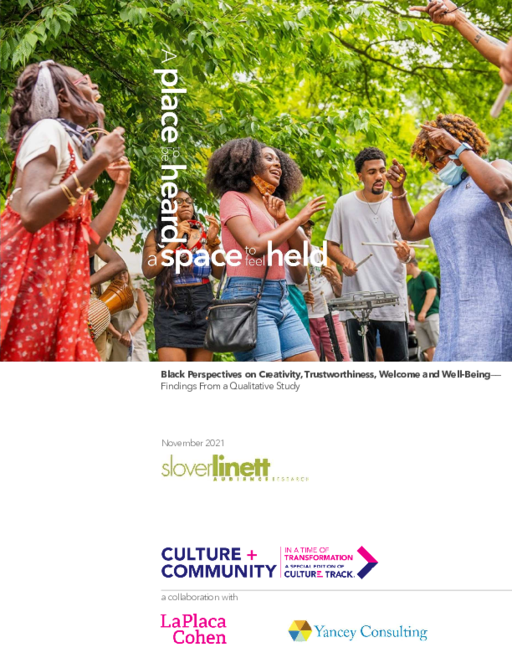- Author(s)
- Melody Buyukozer Dawkins, Ciara K. Knight, Tanya Treptow, and Camila Guerrero
- Publisher(s)
- Slover Linett Audience Research, LaPlaca Cohen, and Yancey Consulting
Research Approach
The researchers interviewed 50 Black Americans from diverse multiracial, multiethnic, immigrant, and LGBTQIA+ communities. Participants came from suburban, urban, and rural areas, and ranged in age from 20 to 76. The group spanned different levels of participation and skill in the arts. Interviews took 90 minutes.
Nearly half of the participants were sourced by a third-party research agency, whereas the remaining participants were chosen from people who had previously expressed an interest in being interviewed following outreach by organization advisors. These people were initially identified through the 2020 Centering the Picture report’s pool of interviewees.
Most participants had a bachelor's degree and an income of $50,000 to $99,000. There were 11 people from the northeast, 8 from the west, 21 from the South, and 10 from the midwest, with Black women and Southern Black Americans having the highest representation. Exact demographics, however, were unclear due to non-mandatory responses to demographic questions.
Interview Process
The interviews were largely online and conducted via Zoom video and phone calls. Researchers started the interview with an ice-breaker exercise, and used a semi-structured “discussion guide” developed with advisers and project partners. After introducing the interviewer and their goals, they launched a starting exercise on joy, connection, and self-expression. This usually involved asking the interviewee about activities that generated personal joy or purpose, provided a sense of connection with others, and allowed individuals to authentically express themselves.
They would then ask interviewees to talk about a time when they felt comfortable and welcomed by a group. To ensure culturally responsive research practices, the researchers focused on asking questions about positive experiences. They used a wide-ranging list of topics, including on artistic creativity, community support, a sense of belonging, trustworthiness, and activities during the Covid-19 pandemic. Some interviewees also voluntarily shared negative and traumatic events.
The interview concluded by allowing participants to share feedback, questions, and final thoughts. Researchers offered them a thank you gift and allowed them to use the conclusion to express their creativity through art, craft, or writing.
In terms of research framing, the researchers said that the opinions of the 50 participants did not encompass the complete range of opinions among all Black Americans nationwide, nor did they include the perspective of Black Americans who faced barriers accessing the internet.

